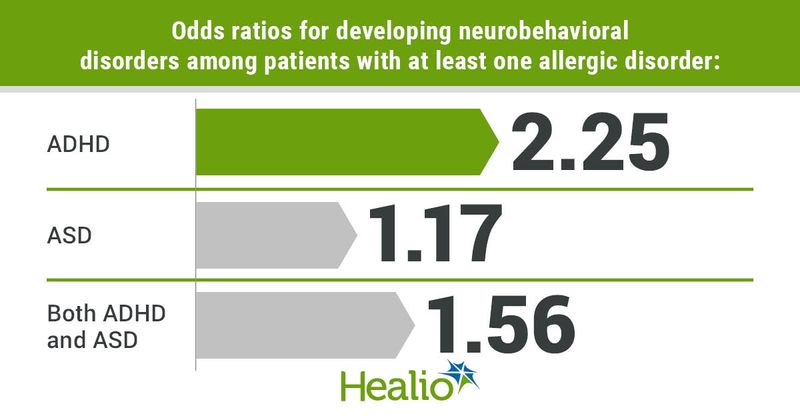Allergic disorders in early childhood associated with risks for ADHD, autism
Click Here to Manage Email Alerts
Allergic disorders in early childhood significantly increase the risks for ADHD and, to a lesser extent, autism spectrum disorder, according to a study published in Pediatric Allergy and Immunology.
Treating these allergic disorders early and effectively could reduce the development of these neurobehavioral disorders, Shay Nemet, MD, of the allergy and immunology clinic and Neve Or HIV Institute at Kaplan Medical Center in Rehovot, Israel, and colleagues wrote.

The retrospective study examined data from 119,874 male and 114,323 female patients aged 18 years and younger treated by Clalit Health Services in Israel 2000 and 2018. The mean follow-up period for all enrolled patients was 11 ± 6 years (range, 2-18 years).
The population included 117,022 patients diagnosed with at least one allergic disorder during the study period (mean age at diagnosis, 4.5 years ± 4.3 years). The most prevalent allergic disorders included 49.6% with allergic skin diseases, 41.5% with conjunctivitis and 32.8% with asthma, with approximately 40% of patients with allergies having two or more types of allergic disorders.
Also, the researchers found that 14% of patients overall were diagnosed with ADHD (mean age at diagnosis, 8.5 years ± 3.4 years), 0.99% were diagnosed with autism spectrum disorder (ASD; mean age at diagnosis, 5.1 years; ± 3.5 years) and 0.34% were diagnosed with both ADHD and ASD (mean age at diagnosis, 5 years ± 2.9 years).
A significantly greater proportion of patients diagnosed with ADHD also had vs. did not have an allergic disorder (19.3% vs. 8.9%; P < .0001).
Also, 1.1% of patients with an allergic disorder were diagnosed with ASD as well, compared with 0.9% of patients with ASD but no allergic disorders (P < .0001). Similarly, 0.4% of patients diagnosed with an allergic disorder and 0.3% of patients without an allergic disorder also were diagnosed with both ADHD and ASD (P < .0001).
The researchers additionally found that 95% of patients with ADHD and 97% of patients with ASD were diagnosed with one or more allergic disorder before they had been diagnosed with their neurobehavioral disorder.
The presence of at least one allergic disorder presented a significantly increased risk for developing ADHD (OR = 2.25; 95% CI, 2.39-2.51), ASD (OR = 1.17; 95% CI, 1.08-1.27) or both ADHD and ASD (OR = 1.56; 95% CI, 1.35-1.79).
Specifically, early diagnosis of rhinitis presented the highest risk for developing ADHD (OR = 3.958; 95% CI, 3.801-4.122), followed by early diagnosis of allergic conjunctivitis (OR = 3.36; 95% CI, 3.53-3.74).
Genetics and environmental and socioeconomical factors may influence the relationship between allergic and neurological disorders such as ADHD and ASD, the researchers wrote, but they could not be evaluated in the retrospective study.
In addition to potential genetic and environmental factors, the researchers continued, the mechanisms behind this association between allergic and neurological disorders may include the stress, fear and sleep disturbances experienced by children with allergic disorders as well as the early use of antihistamine agents that pass the brain-blood barrier.
By effectively treating allergic disorders including sleep disorders, stress and other physical discomforts early, the researchers said, providers may reduce the development of ADHD, ASD and other neurobehavioral disorders.
